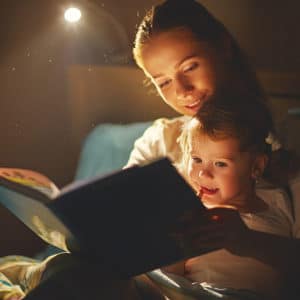There is a world of possibilities, with books and toys, to stimulate your child’s imagination and language during their early years. Reading is perhaps the one singular most important activity to help stimulate language development for children. Reading to your children long after they can read to themselves helps to continue their development of ideas and thoughts beyond their reading level. A close second to reading to your child, is talking while playing with your child. This is why toys are often considered children’s ‘work’ and learning to play with toys is an important foundation skill.

Ages 0-2
Books for this age group include board books and illustrated books. Board books allow infants to touch, feel, bend, mouth and throw the books without damaging the pages! Many board books have stories (such as Good Night Moon), some have few to no words at all (Good Night Gorilla) and some help children learn specific vocabulary (such as colour and shape books). Illustrated books for this age group include stories that can be read to your child even though they are not speaking or do not understand the vocabulary. These books often have beautiful illustrations to help capture a child’s attention (The Moment you were Born, You are my Happy).
Toys are also an important part of an infant’s language development. Playing with toys that rattle, squeak and crinkle to gain a child’s attention when practicing “tummy time” help lay the building blocks of language development by matching sounds to words. This is also true for cause and effect toys (ones that you press a button and something happens), blocks, shapes or stacking rings. Each of these toys, paired with an adult providing the words to the actions, form a powerful bond of language development and enrichment.
Language Development Pro-tip: Age 0-2
Using a variety of words to describe an object is wonderful but using too many words can be overwhelming. A general rule of thumb is sentences should be one word more than the age. For a sentence focused on tidying up, consider: “yellow car in” or “put car in” or “car in basket”.
Ages 3-5
Books and toys change as a child’s interest grows and expands. To continue laying the foundation for language development, read to your child everyday by choosing books that match your child’s interest. Some of my favorites include Olivia books, Eric Carle books and Construction site books. If you have a superhero fan on your hands, a child friendly graphic novel is a perfect way to engage them in a story. Some children prefer books that have real pictures about real things such as trains, construction vehicles or community helpers. Regardless of the interest there is almost always an age appropriate book to match.
Matching toys to interest and providing words for all the amazing ways the toy can be handled can help drive creativity and pique their curiosity. Find toys that can be played with in more than one-way and allow opportunity for interaction. Other examples of toys for this age help children pretend and re-enact observations from their daily life. Toys at this age group can include kitchen sets, tool sets, dolls, vehicles, small people sets, puppets and building toys — all of these allow create opportunities for imagination to blossom and the words and language to go with it. Playing together increases the opportunities to help develop new vocabulary words and how to put it all together in sentences.
Language Development Pro-tip: Age 3-5
Resist the urge to ask your child to repeat the words after you. Communication is always most abundant in authentic and natural settings (such as when you are reading or playing together)!











